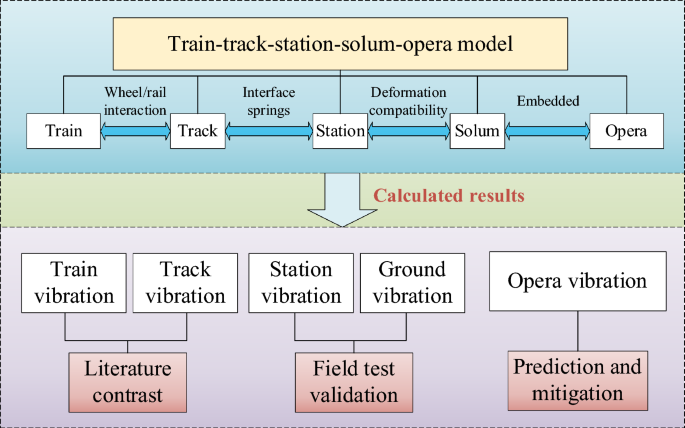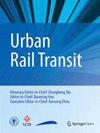地铁站附近歌剧院地铁诱发振动的评估、预测和缓解:一个案例研究
IF 2.9
4区 工程技术
Q4 TRANSPORTATION
引用次数: 0
摘要
城市的快速扩张和城市轨道交通网络的发展导致了地铁沿线振动环境的恶化。这些长期的振动对邻近的建筑(如歌剧院)和附近居民的健康构成了重大挑战。因此,迫切需要进行振动评估和实施缓解解决方案。这项工作提供了一个数值调查的振动动力学观察位于地铁站上方的歌剧院。提出了一种统一的列车-轨道-车站-索伦-歌剧模型,并通过现场试验进行了验证。通过采用接触理论、变形协调准则和弹簧单元,对各个部件进行了细致的建模和耦合。利用这种统一的耦合方法,对歌剧院的地铁诱发振动进行了预测和评估。此外,从传递路径和振动接收器的角度采取了振动控制措施,以减轻和隔离过度的剧院振动。以地铁线路与歌剧院之间的距离为42米为例,结果表明,地铁运行可能导致地铁站附近歌剧院的振动超出可接受范围。因此,在沿地铁线路建造对振动敏感的建筑物之前,必须对振动进行评估,并采取缓解措施以满足规范要求。在这项工作中,挤压聚苯乙烯(XPS)板的应用和建筑结构的优化有效地减少了1-2.5 dB的过度剧院振动,提供了可行的衰减选择,而无需修改现有的地铁系统。本文章由计算机程序翻译,如有差异,请以英文原文为准。

Assessment, Prediction, and Mitigation of Metro-Induced Vibrations for an Opera Theatre Adjacent to a Station: A Case Study
Abstract Rapid urban expansion and the development of urban rail transit networks have led to a deteriorating vibration environment along metro lines. These long-term vibrations pose significant challenges to adjacent buildings, such as opera theatres, and to the well-being of nearby residents. Consequently, there is a critical need for vibration evaluation and the implementation of mitigation solutions. This work provides a numerical investigation into the dynamics of vibrations observed in an opera theatre located above a metro station. A unified coupling method, known as the train-track-station-solum-opera model, is proposed and validated with field experiments. By employing contact theory, deformation coordination criteria, and spring elements, various components are meticulously modeled and coupled. Using this unified coupled approach, metro-induced vibrations at the opera theatre are predicted and evaluated. Additionally, vibration control measures are employed from the perspectives of transfer paths and vibration receivers to mitigate and isolate excessive theatre vibrations. The results, based on a case where the distance between the metro line and the opera theatre is 42 m, demonstrate that metro operations can lead to vibrations exceeding acceptable limits at the opera theatre near the metro station. Therefore, it is imperative that vibrations are assessed before constructing vibration-sensitive buildings along metro lines and that mitigation measures are implemented to meet specifications. In this work, the application of extruded polystyrene (XPS) plates and optimization of building structures effectively reduced excessive theatre vibrations by 1–2.5 dB, offering viable attenuation options without requiring modifications to the existing metro system.
求助全文
通过发布文献求助,成功后即可免费获取论文全文。
去求助
来源期刊

Urban Rail Transit
Multiple-
CiteScore
3.10
自引率
6.70%
发文量
20
审稿时长
5 weeks
期刊介绍:
Urban Rail Transit is a peer-reviewed, international, interdisciplinary and open-access journal published under the SpringerOpen brand that provides a platform for scientists, researchers and engineers of urban rail transit to publish their original, significant articles on topics in urban rail transportation operation and management, design and planning, civil engineering, equipment and systems and other related topics to urban rail transit. It is to promote the academic discussions and technical exchanges among peers in the field. The journal also reports important news on the development and operating experience of urban rail transit and related government policies, laws, guidelines, and regulations. It could serve as an important reference for decision¬makers and technologists in urban rail research and construction field.
Specific topics cover:
Column I: Urban Rail Transportation Operation and Management
• urban rail transit flow theory, operation, planning, control and management
• traffic and transport safety
• traffic polices and economics
• urban rail management
• traffic information management
• urban rail scheduling
• train scheduling and management
• strategies of ticket price
• traffic information engineering & control
• intelligent transportation system (ITS) and information technology
• economics, finance, business & industry
• train operation, control
• transport Industries
• transportation engineering
Column II: Urban Rail Transportation Design and Planning
• urban rail planning
• pedestrian studies
• sustainable transport engineering
• rail electrification
• rail signaling and communication
• Intelligent & Automated Transport System Technology ?
• rolling stock design theory and structural reliability
• urban rail transit electrification and automation technologies
• transport Industries
• transportation engineering
Column III: Civil Engineering
• civil engineering technologies
• maintenance of rail infrastructure
• transportation infrastructure systems
• roads, bridges, tunnels, and underground engineering ?
• subgrade and pavement maintenance and performance
Column IV: Equipments and Systems
• mechanical-electronic technologies
• manufacturing engineering
• inspection for trains and rail
• vehicle-track coupling system dynamics, simulation and control
• superconductivity and levitation technology
• magnetic suspension and evacuated tube transport
• railway technology & engineering
• Railway Transport Industries
• transport & vehicle engineering
Column V: other topics of interest
• modern tram
• interdisciplinary transportation research
• environmental impacts such as vibration, noise and pollution
Article types:
• Papers. Reports of original research work.
• Design notes. Brief contributions on current design, development and application work; not normally more than 2500 words (3 journal pages), including descriptions of apparatus or techniques developed for a specific purpose, important experimental or theoretical points and novel technical solutions to commonly encountered problems.
• Rapid communications. Brief, urgent announcements of significant advances or preliminary accounts of new work, not more than 3500 words (4 journal pages). The most important criteria for acceptance of a rapid communication are novel and significant. For these articles authors must state briefly, in a covering letter, exactly why their works merit rapid publication.
• Review articles. These are intended to summarize accepted practice and report on recent progress in selected areas. Such articles are generally commissioned from experts in various field s by the Editorial Board, but others wishing to write a review article may submit an outline for preliminary consideration.
 求助内容:
求助内容: 应助结果提醒方式:
应助结果提醒方式:


